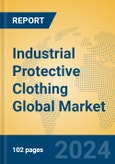Market Size
The industrial protective clothing market is projected to grow from USD 12.5 billion in 2025 to USD 19.8 billion by 2030, registering a compound annual growth rate (CAGR) of 9.6%. This growth is driven by stringent occupational safety standards, increasing demand from industries such as construction, oil & gas, and mining, and advancements in protective fabric technologies.Market Share & Trends Analysis
By Application
The market is segmented by application, with estimated growth rates as follows:- Construction: Accounts for 25% to 30% of the market, with a CAGR of 8% to 10%, driven by expanding infrastructure projects and workplace safety compliance.
- Manufacturing: Holds 20% to 25% of the market, with a projected CAGR of 9% to 11%, fueled by rising demand for fire-resistant and chemical-protective clothing.
- Oil & Gas: Represents 15% to 20% of the market, with a CAGR of 10% to 12%, owing to high-risk working conditions and the need for flame-retardant apparel.
- Mining: Covers 10% to 15% of the market, growing at a CAGR of 9% to 11%, driven by rising safety concerns in hazardous environments.
- Others: Includes sectors such as healthcare, firefighting, and chemical processing, contributing 10% to 15% to the market, with a CAGR of 8% to 10%.
By Product Type
- Aramid & Blends: Holds 30% to 35% of the market, with a CAGR of 9% to 11%, widely used for high-performance flame-resistant protective wear.
- Polyolefin & Blends: Accounts for 20% to 25% of the market, growing at a CAGR of 8% to 10%, known for chemical and heat resistance.
- Polyamide: Represents 15% to 20% of the market, with a CAGR of 9% to 11%, valued for its durability and abrasion resistance.
- Polybenzimidazole (PBI): Covers 10% to 15% of the market, projected to grow at a CAGR of 10% to 12%, offering high thermal resistance.
- Others: Includes cotton-based and disposable protective clothing, holding 10% to 15% of the market, with a CAGR of 7% to 9%.
By Key Market Players
Leading companies in the industrial protective clothing market include:- Honeywell: A key manufacturer of high-performance safety apparel.
- DuPont: Offers innovative protective clothing solutions such as Nomex® and Kevlar®.
- 3M: Develops chemical-resistant and fireproof clothing for various industries.
- Ansell: Specializes in protective apparel for chemical and biological hazards.
- Lakeland Industries: Produces industrial-grade protective wear for hazardous environments.
- Alpha Pro Tech: Focuses on medical and industrial protective clothing.
- Sioen Industries: A leading provider of high-quality safety and flame-resistant workwear.
- Radians: Manufactures high-visibility protective clothing.
- MSA Safety: Develops safety gear and industrial protective clothing.
- COFRA: Offers a wide range of workwear for industrial and construction workers.
- FallTech: Specializes in protective gear for fall prevention in construction and industrial applications.
By Region
The industrial protective clothing market is expanding at different rates across regions:- North America: Holds 35% to 40% of the market, with a CAGR of 8% to 10%, driven by strict workplace safety laws and technological advancements.
- Europe: Accounts for 25% to 30% of the market, growing at a CAGR of 7% to 9%, supported by stringent EU safety regulations.
- Asia-Pacific: The fastest-growing region, with a CAGR of 10% to 12%, fueled by rapid industrialization and rising awareness of worker safety.
- Latin America: Expected to grow at a CAGR of 7% to 9%, with increasing demand from oil, gas, and construction sectors.
- Middle East & Africa: Projected to grow at a CAGR of 6% to 8%, driven by expanding mining and oil & gas industries.
Market Forecasts (2025-2030)
Key Growth Drivers
- Stringent Workplace Safety Regulations: Government-mandated safety standards are pushing industries to adopt high-quality protective wear.
- Increasing Industrialization: Growth in construction, mining, and manufacturing sectors is driving demand for industrial protective clothing.
- Advancements in Protective Fabrics: Development of lightweight, high-performance materials is improving comfort and durability.
Market Restraints
- High Cost of Advanced Protective Clothing: Premium protective gear with enhanced safety features remains expensive.
- Compliance Challenges in Emerging Markets: Lack of strict enforcement of workplace safety regulations in some regions limits market expansion.
Opportunities
- Growing Demand for Sustainable Protective Wear: Rising focus on eco-friendly and recyclable materials presents new opportunities.
- Expanding Applications in Emerging Industries: Increased demand from the healthcare and chemical industries is boosting market growth.
Market Threats
- Competition from Low-Cost Alternatives: The presence of inexpensive, non-compliant alternatives poses a challenge to premium brands.
- Supply Chain Disruptions: Fluctuations in raw material availability and logistics issues may impact market growth.
This product will be delivered within 1-3 business days.
Table of Contents
Companies Mentioned
- Honeywell
- DuPont
- 3M
- Ansell
- Lakeland Industries
- Alpha Pro Tech
- Sioen Industries
- Radians
- MSA Safety
- COFRA
- FallTech








